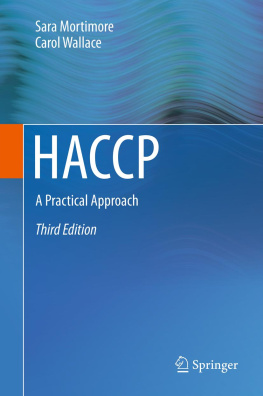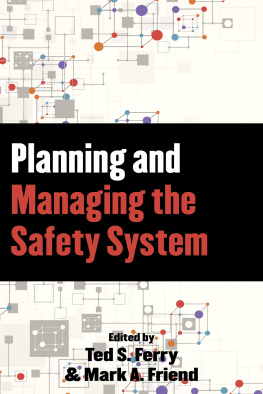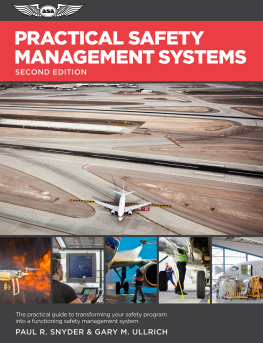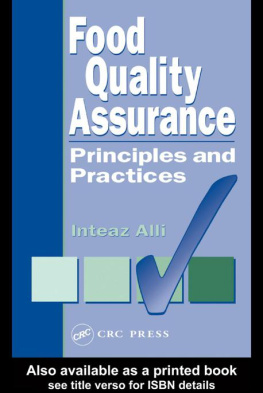1. An Introduction to HACCP and Its Role in Food Safety Control
HACCP is the well-known acronym for the Hazard Analysis and Critical Control Point system. It has been frequently written about and talked about at conferences and within companies over the last 50 years but is still often misunderstood and poorly applied in real situations.
Since we last updated this book there have continued to be many failures in the food supply chain. Some of these are world renowned (e.g., melamine in milk powder from China), many were significant national failures (e.g., Salmonella in peanut butter in the USA, Salmonella in chocolate in the UK, E. coli in sprouted seeds in Germany), and many, many more were small, isolated, and sometimes tragic events occurring in countries all around the world. So what has gone wrong? Is HACCP not working? Sadly, the answer to this question is that it hasnt had a chance to work. Far from being done, HACCP has been poorly implemented and under-utilized in probably the majority of food companies.
The HACCP concept has been around in the food industry for a long time, yet food safety control continues to be debated rigorously at the international level and there continues to be calls for new committees, new agencies, and new laws to fix the problem. Twenty years ago developments in HACCP were fairly major, and some governments saw its implementation as a remedy for all of their countrys food safety issues. In reality, use of the HACCP approach does offer a practical and major contribution to the way forward, but only if the people charged with its implementation have the proper knowledge and expertise to apply it effectively. Foodborne illness continues to be a major problem that must be addressed. We cannot go another 20 years and still be searching for solutions. Consumers have a right to expect that each product produced and sold will be safe for consumption.
HACCP is a tool that can be used to reduce the risk of a food safety failure. However, the food industry has failed to use it effectively to do that, often by spending time in writing and updating the documents, as opposed to recognizing that the thought and application process is the key to food safety assurance. Many companies think they have a HACCP system because they have a written HACCP plan, yet frequently the content of the plan is poor and adds little value in terms of food safety risk reduction. In these cases HACCP needs to be revisited, upgraded, and properly implemented before it can have an impact on food safety risk reduction.
In this chapter, we will consider some of the most common questions asked not only by those who are new to HACCP but also by those who want to take a fresh look and upgrade their food safety systems. We will endeavor to explore some of the reasons for using the systemfor the management of product safety, to meet government and customers expectations and, perhaps less obviously, because it makes good business sense.
1.1 HACCP: The Basic Questions Answered
1.1.1 What Is HACCP?
HACCP is a logical system of food control based on prevention. In identifying where the hazards are likely to occur in the process, we have the opportunity to put in place the measures needed to prevent those hazards from affecting the consumer. This facilitates the move towards a preventative quality assurance approach within a food business and reduces the traditional reliance on end-product inspection and testing.
In brief, HACCP is applied by taking a number of straightforward steps:
Understand your productwhat is making it safe?
Look at your production process from start to finishunderstand your operating environment and process activities.
Identify potential hazards and decide where they could occur in the process.
Put in preventative control measures with defined safety limits.
Monitor the controls.
Write it all down and keep records as evidence that youve done it.
Ensure that it continues to work effectively.
All types of food safety hazards are considered as part of the HACCP systembiological, chemical, and physical. Effective implementation of a HACCP-based food safety system should, therefore, give the growers, manufacturers, food service operators, and retailers confidence that the food they provide is safe. This can and should involve everyone in the company as each employee has a role to play. This is a fundamental requirement that is often forgotten: the systems element is not just about documentation, it is also a people system. The people who use it own itthey maintain it and keep it current. Our first edition of this book was published in 1994, nowadays there are few people in the industry who havent heard of HACCP but there are many who have lost sight of the fact that you need people who know how to get it done and who are accountable. The culture that evolves through this systems/people approach not only makes it more likely to succeed but makes it much simpler to progress to additional programs such as quality improvement, productivity, and cost reduction.
1.1.2 What Are the Principles of HACCP?
The HACCP system consists of seven principles which outline how to establish a HACCP plan for each operation under study. The HACCP principles have international acceptance and details of this approach have been published by the Codex Alimentarius Commission ().
We are now going to introduce a number of terms which may be unfamiliar to you if you are just starting out. There is a glossary in Appendix when we look at applying the principles.
Principle 1
Conduct a hazard analysis . Prepare a list of steps in the process, identify where significant hazards could occur, and describe the control measures.
Principle 1 describes where the HACCP team should start. A Process Flow Diagram is put together detailing all the steps in the process, from incoming raw materials to finished product. When complete, the HACCP team identifies all the hazards that could occur at each step, considers the likelihood of their occurrence, and considers the severity of effect to the consumer. This determines the significant hazards and enables the team to go on to describe preventative measures for their control. These may be existing or new control measures.
Principle 2
Determine the Critical Control Points (CCPs) . When all the significant hazards and control measures have been described, the HACCP team establishes the points where control is critical to assuring the safety of the product. These are the Critical Control Points or CCPs.
Principle 3
Establish Critical limits for control measures associated with each identified CCP. The critical limits describe the difference between safe and potentially unsafe product at the CCPs. They must involve a measurable parameter and may also be known as the absolute tolerance or safety limit for the CCP.
Principle 4
Establish a system to monitor control of the CCP . The HACCP team should specify monitoring requirements for management of the CCP within its critical limits. This will involve specifying monitoring actions along with monitoring frequency and responsibility.







